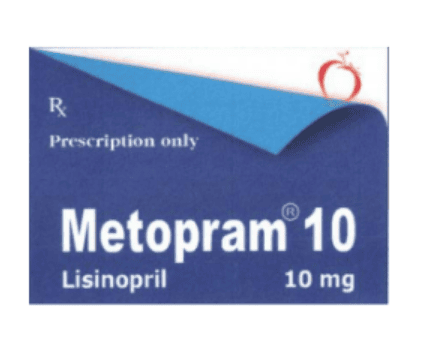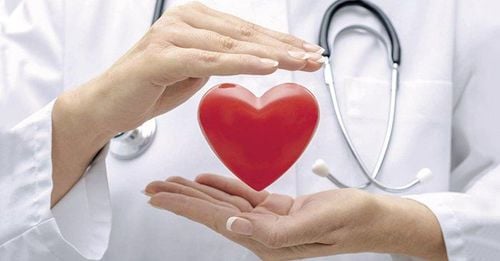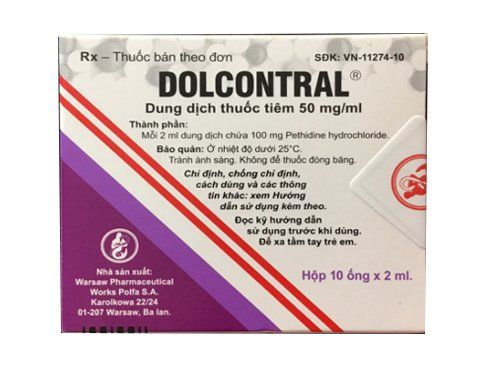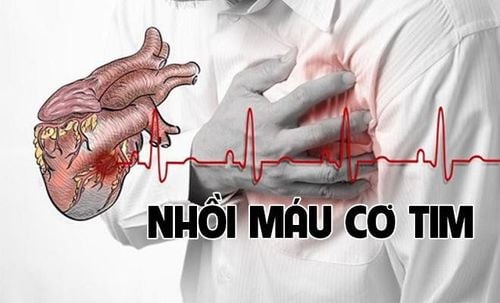This is an automatically translated article.
The article is professionally consulted by Master, Doctor Huynh Khiem Huy - Cardiac Resuscitation Doctor - Cardiovascular Center - Vinmec Central Park International General HospitalAcute myocardial infarction is a dangerous acute disease caused by sudden blockage of blood vessels supplying the heart muscle. When the heart muscle is not supplied with blood, it dies and causes severe chest pain. A quick diagnosis and prompt treatment will determine the patient's survival.
1. Symptoms of acute myocardial infarction
Some symptoms of acute myocardial infarction include:Typical angina: The patient presents with chest pain, a feeling of squeezing pain behind the sternum, or maybe slightly to the left. The pain can radiate to the left shoulder, spreading to the inside of the left hand all the way to the ring and little fingers of the left hand. The pain is similar to angina but lasts more than 20 minutes, and does not get better with nitroglycerin. Some patients may have pain that radiates to the chin, neck, shoulders, back, arms, or epigastrium. In some cases, myocardial infarction can occur without the patient feeling pain or feeling little pain, this is called a silent myocardial infarction. This condition is common in postoperative patients, patients with hypertension, diabetes, the elderly. Patients may experience dyspnea instead of retrosternal pressure, or hiccups due to diaphragmatic irritation during inferior transmural infarction. Patients may have some other symptoms such as: Sweating, palpitations, confusion, nausea or vomiting, gastrointestinal symptoms,... Some patients may have a sudden stroke. Local death is a common consequence of acute myocardial infarction. On physical examination, the doctor may notice the following symptoms: Tachycardia Blurred heart sound, possibly with a galloping sound. A heart murmur may occur. Stagnant rales in the lungs, symptoms of heart failure, acute pulmonary edema. The above clinical symptoms will help guide, differential diagnosis, but not enough to diagnose acute myocardial infarction. To make a diagnosis, it is necessary to do the following laboratory tests:
Electrocardiogram: based on the electrocardiogram, the doctor can not only diagnose whether the patient has an acute myocardial infarction, but also can whether it is a transmural or non-transmural myocardial infarction. Transmural myocardial infarction is a myocardial infarction that causes damage to the ventricular wall. In addition, based on the electrocardiogram, doctors can locate the infarction. Blood tests to do: Creatine Kinase (CK): This cardiac enzyme is CK-MB, CK-MM, CK-BB, respectively, representing the heart muscle, skeletal muscle, and brain. Troponin: includes Troponin T and I. These are two types of cardiac enzymes with high diagnostic value and are quite special for the heart muscle. In addition, this index is also valuable in the prognosis of the disease. LDH: increased after 8 - 48 hours of acute myocardial infarction. SGOT (or AST): begins to increase 8-12 hours after myocardial infarction. These tests not only help confirm the diagnosis but also help to predict the disease, identify the time Echocardiogram is also very valuable in diagnosing myocardial infarction, on ultrasound often images of associated movement disorders are seen. in relation to the site of infarction
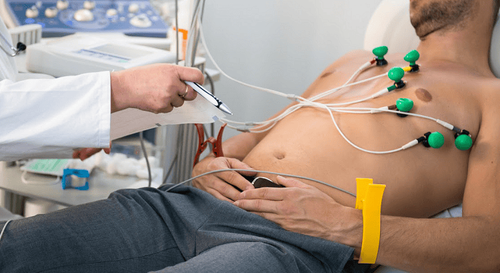
Điện tâm đồ giúp chẩn đoán nhồi máu cơ tim cấp
2. Diagnosis of acute myocardial infarction
2.1. Differential diagnosis
Based on clinical symptoms and laboratory tests, doctors need to differentiate acute myocardial infarction from the following diseases:Chest pain syndrome Acute pericarditis Acute abdominal disease such as: inflammation of the airways acute biliary tract, acute pancreatitis, perforation of hollow viscera. Aortic dissection Large pulmonary artery obstruction Esophageal perforation/rupture Myocardial infarction after coronary bypass surgery Some diseases can mimic acute myocardial infarction such as: cerebral hemorrhage, traumatic brain injury, myopathy disseminated cardiomyopathy, amyloidosis, scleroderma, ventricular hypertrophy....
2.2. Diagnosis of acute myocardial infarction
The definitive diagnosis of acute myocardial infarction is based on the following 3 criteria:Chest pain symptoms Electrocardiogram Cardiac enzyme tests Only 2 out of 3 of the above criteria can be used to diagnose acute myocardial infarction.
3. First aid for acute myocardial infarction
Acute myocardial infarction is an emergency, the patient needs to be quickly taken to the nearest hospital for timely emergency treatment, otherwise it can leave many complications later, even dangerous to life. life at that moment.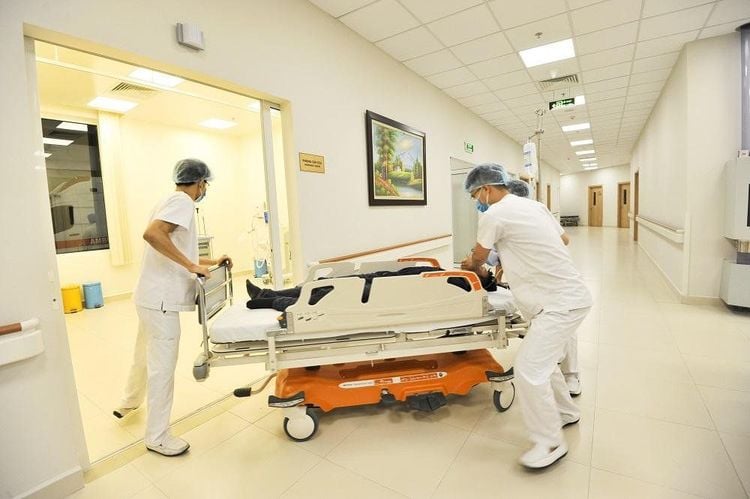
Cấp cứu tại bệnh viện Vinmec
3.1. Principles of first aid for acute myocardial infarction
The patient should be completely immobilized. Pain relief for the patient. Use of nitrates Use of anticoagulants and antiplatelet agents. Block coronary artery circulation to reperfuse the damaged myocardium with thrombolytic drugs or coronary intervention. Need for shock prevention and shock protection. Prevention and treatment of complications.3.2. First aid steps for patients with acute myocardial infarction
The patient remained absolutely motionless in bed for the first 48 hours. After 48 hours, if there is no chest pain and no fatigue, the patient can move the limbs. If no symptoms of chest pain reappear, heart rate does not increase more than 30 beats / minute compared to when lying down, the patient can sit in a chair. After 1 week, the patient can walk gently in the ward. Use of sedatives: Diazepam or Phenobarbital. Pain relief for patients, can use Morphin, Promedol 10mg tube injected under the skin, or injected intramuscularly or intravenously. However, Morphine can cause respiratory depression, so it should be used with caution. Morphine also has the effect of lowering blood pressure, so do not use in shock. Prophylaxis of shock by placing intravenous lines, breathing oxygen. Nitrate Use: Nitroglycerin (Nitromint). Record electrocardiogram or set up monitoring. Treatment with thrombolytics: r-TPA or Streptokinase, Urokinase. Surgical treatment (if thrombolytic drugs are not effective). Surgical treatment can be percutaneous vascular intervention, coronary artery bypass graft surgery. Treatment of microvascular dilation after vascular intervention or thrombolysis is by infusion of a vasodilator such as calcium channel blockers, adenosine or nitroprusside into the coronary arteries. Use of anticoagulants and antiplatelets: Anticoagulants: Heparin, direct thrombin inhibitors. Antiplatelet drugs: Aspirin, Ticlopidine, Abciximab, Eptifibatide, Tirofiban,... Prevention of recurrence: some experts recommend beta-blockers during the recovery period. Today, we have made great progress in the treatment of acute myocardial infarction, including measures to open blocked coronary arteries with thrombolytic drugs or vascular interventions to reperfuse the area. damaged heart muscle due to infarction. This has helped bring more survival chances for the unfortunate patient with acute myocardial infarction.Master. Dr. Huynh Khiem Huy has more than 11 years of experience working in the field of cardiovascular resuscitation anesthesia; examination and resuscitation treatment after surgery for cardiovascular diseases in adults and children. Dr. Huy was former deputy head of the Department of Surgical Resuscitation at Tam Duc Heart Hospital before becoming a cardiologist in Cardiovascular Surgery, Cardiovascular Center - Vinmec Central Park International General Hospital
To protect heart health In general and to detect early signs of myocardial infarction and stroke, customers can sign up for the Cardiovascular Screening Package - Basic Cardiovascular Examination of Vinmec International General Hospital. The examination package helps to detect cardiovascular problems at the earliest through tests and modern imaging methods. The package is for all ages, genders and is especially essential for people with risk factors for cardiovascular disease.
Customers can directly go to Vinmec Health system nationwide to visit or contact the hotline here for support.





